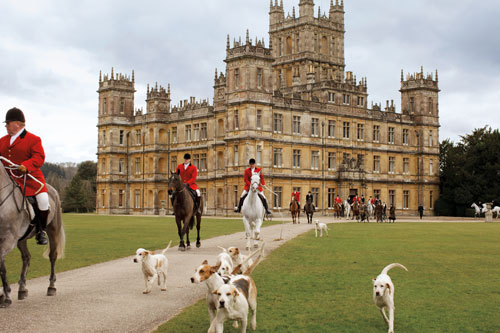Inside Downton Abbey’s Library
Lord Grantham caused a biblio-brouhaha when he casually claimed ownership of a Gutenberg Bible in season four of the popular PBS drama series set within Highclere Castle, aka the real “Downton Abbey.” Now to herald the show’s final season, we ask, what’s really inside that opulent library?By Martha Steger Martha Steger, a Midlothian, Virginia–based freelance writer, received first place in travel writing from the National Federation of Press Women in 2015. One of the two articles for which she was recognized was “Hemingway’s Havana,” which ran in FB&C’s winter 2015 issue.

The hour’s drive north from London culminated at a long, packed-earth driveway past a field of grazing horses. As visitors disembarked, they took in the sweeping vista of Highclere Castle—the real “Downton Abbey”—a family estate on which the spectacularly popular television series is based. From pent-up excitement and awe at the stately structure before them, a group of American tourists on holiday this past September were speechless for two seconds. “Then there’s a collective ‘Ah!’ from us all,” said Jeff Marcoe, executive director of government affairs for the US Chamber of Commerce, after touring the home of the 8th Earl and Countess of Carnarvon, who presently live there.
The 1842 neo-Gothic exterior elements are impressive for their similarity to the Houses of Parliament at Westminster; Sir Charles Barry designed both structures. Stepping inside the privately owned castle that is the centerpiece of a six thousand-acre farm on the lush border of Hampshire and Berkshire counties, however, manages to give the impression of Victorian coziness (if there isn’t a long line of tourists, that is).
For some Downton pilgrims, the formal dining room—site of so many acerbic comments dished out by the Dowager Countess—is of particular interest, as is the passageway (“saloon”) from the service area into the dining room because intriguing assignations often take place here among the fictional household staff. Bedrooms are conveniently labeled to show which characters sleep where: the one at the top of the stairs is Lady Cora’s; the portico bedroom belongs to Lady Sybil; and the Arundel room harbors Lady Edith.
Both on screen and in reality, the castle’s library is a focal point. Jessica Fellowes, author most recently of A Year in the Life of Downton Abbey and niece of Julian Fellowes, the show’s creator, writer, and executive producer, said, “Julian chose Highclere for the film precisely because it’s so Victorian. The library is old Highclere—no changes at all. Popular thinking in Victorian England was that changing an interior required an act of God.”
Highclere’s library was part of Barry’s original design, but it was Sir Thomas Allom who completed it after Barry’s death. The library’s collection has been built up by all of the earls and countesses who have lived there to its present 5,650 titles covering subjects ranging from history and politics to travel and religion.
Upon entering the room, one is greeted by Stephen Hyde Cassan’s Lives of the Bishops of Winchester, Lives of the Bishops of Sherbourne and Salisbury, Lives of the Bishops of Bath and Wells, et al., which are shelved to the right of the library door. The Bishops of Winchester, incidentally, owned this estate from the eighth century and had their medieval palace on the grounds, after which another house was built on its foundations. The original Highclere site was recorded in the Domesday Book, the great survey of much of England and Wales conducted in 1086. Everything fell to rack and ruin after the death of Bishop William of Wykeham in 1404, and the lands were leased for farming. The Carnarvon family acquired it in 1679.







